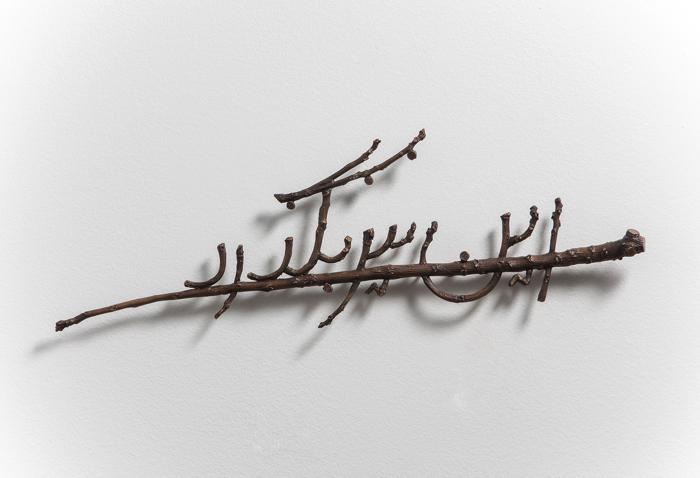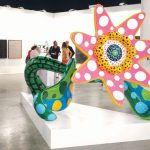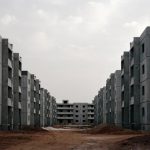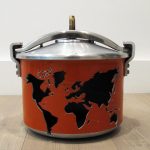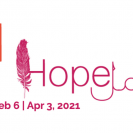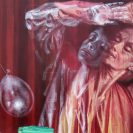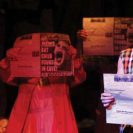Move over New York and Paris…here comes Dubai, a dynamic arts destination, packed with over 40 million US dollars worth of art. bazaar brings you a retrospective look at one of the world’s leading showcases of contemporary art in the Middle East, North Africa and South Asia.
Art Dubai, now in its seventh year, once again brought together internationally renowned galleries exhibiting contemporary art, photography, sculpture, video installations, and kinetic art.
The events participation of over 75 galleries from 30 different countries representing 500 artists was a great opportunity to see art in all its diverse genres.
The Global Art Forum successfully brought together a diverse lineup of artists, musicians, curators, strategists, writers and thinkers, under the title ‘It Means This’ and explored the concept of ‘definitionism,’ taking to task the words, phrases and clichés that proliferate in the art world today.
The forum unfolded at Mathaf: Arab Museum of Modern Art, Doha (March 17–18, 2013) and continued at Art Dubai, Madinat Jumeirah (March 20–23). The programme was directed by Istanbul-based writer/editor HG Masters, and commissioned by writer/curator Shumon Basar.
‘Marker’ Project, a curated section of concept stands was curated by Lagos-based curator Bisi Silva, and explored the nature of changing cities through the work of artists and arts organizations from West Africa.
One of the most interesting works at the project was Head Series (No. 6) by Taiye Idahor, an eloquent visual in mixed media. She had juxtaposed newspaper, film cartridge, and acrylic paint on wood to create her work.
A plethora of styles, mediums, and art forms abounded at this cutting edge gallery, which rightfully received considerable attention for displaying some of the stars. Rose Issa Projects, a London based gallery, had some intriguing works on display, including pieces by Taraneh Hemami, Batoul S’Himi, and Hossein Valamanesh.
Some of the strongest works were by Batoul S’Himi, who made a particular splash at the show with a piece entitled Un Monde Sous Pression (A World Under Pressure), which sought to express the symbolism of everyday modern life. Her works echo strong narratives of identity; specifically, the myriad facets of the Moroccan female universe.
The Third Line, a Dubai based art gallery, proved to be a stronghold for curious visitors. It represented some particularly wonderful artists such as Abbas Akhavan, Farhad Moshiri, Golnaz Fathi, Hassan Hajjaj, Lamya Gargash, Monir Shahroudy Farmanfarmaian, Rana Begum, Shirin Aliabadi, Sophia Al-Maria, Tarek Al-Ghoussein and Youssef Nabil.
It was a sheer treat for visitors to savor the works of Farmanfarmaian, an Iranian artist of great repute, known for her intricate aineh-kari or mirror mosaic and reverse glass-painting sculptures.
In a selection of hand-painted gelatin silver prints, Egyptian artist Nabil explored the displacement and disconnect he feels with his home country and the rest of the world.
Sabrina Amrani Art Gallery, based in Madrid, Spain, showcased the works of Zoulikha Bouabdellah, Waqas Khan, Nicène Kossentini and UBIK.
According to the Sabrina Amrani Art gallery notes, “in our modern society, the West and the Orient are depicted in an eternal conflict: social, cultural and political. Zoulikha’s architectural doors are the representation of an opposite idea where both sides are living harmoniously.” The artist offers her own vision of an era where identity is no longer related to the concepts of borders or nations by fusing arches from different times and origins.
Athens-based Kalfayan Galleries had brought down some of the finest works by Vartan Avakian, Rania Bellou, Emmanouil Bitsakis, Nina Papaconstantinou, Pietro Ruffo, Hrair Sarkissian and Dimitris Tataris.
A welcome surprise to wandering visitors was the work of avant-garde artist, Yayoi Kusama, also known as the Polka Dot Queen. This acclaimed Japanese artist was represented by London-based Victoria Miro Gallery.
Art aficionados were spoiled for choice at Etemad Gallery which showcased Morteza Ahmadvand, Mehrdad Mohebali, Leila Pazooki, Parviz Tanavoli, Sadegh Tirafkan, and Ramtin Zad. A fiberglass sculpture titled, Twisted Blue Heech by Iranian artist Parviz Tanavoli was stunning and one of the biggest crowd pleasers at Art Dubai.
Tanavoli, who was a founding member of the Saqqakhaneh movement that began in the 60s in Iran, sought to integrate popular symbols of Shia culture in art. The term Heech means ‘nothing’ in Persian. It symbolizes, to the artist, ambivalence to the past and present. Adding dimension to word, Tanavoli shot to fame in 2005, when he created a small sculpture called Heech in a Cage to protest against the conditions of the prisoners being held at Guantanamo Bay.
Some other outstanding works on view were by Syrian artist Fadi Yazigi, Palestinian artist Laila Shawa, Lebanese artist Pascal Hachem and Tunisian artist el Seed.
Ayyam Gallery showcased works by Tammam Azzam, Oussama Diab, Khaled Jarrar, Nadim Karam, Mouteea Murad and Mehdi Nabavi.
Ayyam Gallery also hosted exhibitions of solo works by Iranian artist Ashfin Pirhashemi and Kuwaiti artist Shurooq Amin in their Dubai spaces. Drawing considerable attention were the works of Amin, whose Popcornography series had charm and impact. Her new series of 15 paintings examines a number of taboos in the Arab world and were packed with raw emotive power.
Of course, one could not fail to notice the wit underlying Pakistani artist Ehsan Ul Haq’s 12 life-sized donkeys. Art Dubai had commissioned Ul Haq’s installation piece History Lessons for this year’s edition. The artist explains that his work is a satire on the dynamics of power play and masculinity.
In addition, the works of 2013 Abraaj Group Art Prize winners — Vartan Avakian (Lebanon), Iman Issa (Egypt), Huma Mulji (Pakistan), Hrair Sarkissian (Syria), and Rayyane Tabet (Lebanon) were unveiled at Art Dubai.
Other attractions included a new sculpture on the beach section at Mina A’Salam that showcased a 9m-curved bridge by iconic American sculptor Chris Burden.
Art Dubai Projects 2013 were dedicated to the memory of the late Iranian female artist Farideh Lashai (1944-2013).
One of the most interesting aspects of the event was an on-site radio station that made it possible for art fair broadcasts to be made available via a live radio web stream, thus enabling global audiences to digitally experience Art Dubai.
Striking all the right notes, New York-based Kuwaiti musician Fatima Al Qadiri composed a series of short audio pieces to be amplified at pre-determined times of day, providing visitors with a soundtrack to the event.
Art Dubai’s presentation and offerings reached out to a younger audience as well. A positive aspect of the show was the launch of Sheikha Manal ‘Little Artists’ Program, which consisted of workshops and tours for children and teenagers. In an outreach to a wider audience, Art Dubai 2013 introduced the ‘Mobile Art Gallery’ that operated from a truck.
Summing up the essence of Art Dubai, Fair Director Antonia Carver acknowledges that the status and scope of the event reflected Dubai’s growing stature as an international art hub, and one couldn’t agree more. The seventh edition of Art Dubai certainly exceeded expectations.
For more information, visit www.artdubai.ae Images courtesy of Art Dubai/Galleries.

